2015 TOYOTA CAMRY HYBRID radio
[x] Cancel search: radioPage 326 of 564
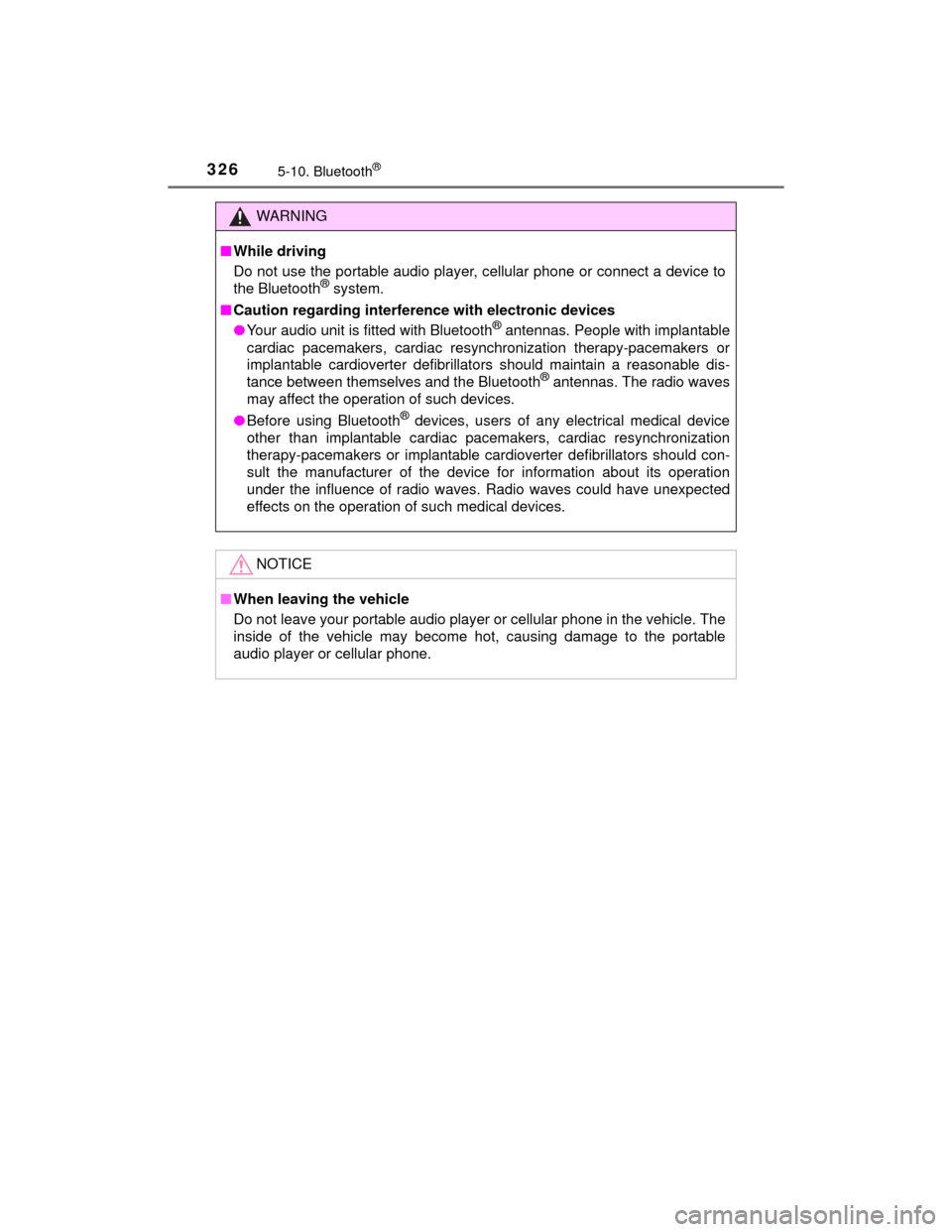
3265-10. Bluetooth®
CAMRY_HV_U (OM33A87U)
WARNING
■While driving
Do not use the portable audio player, cellular phone or connect a device to
the Bluetooth
® system.
■ Caution regarding interference with electronic devices
●Your audio unit is fitted with Bluetooth
® antennas. People with implantable
cardiac pacemakers, cardiac resynchronization therapy-pacemakers or
implantable cardioverter defibrillators should maintain a reasonable dis-
tance between themselves and the Bluetooth
® antennas. The radio waves
may affect the operation of such devices.
● Before using Bluetooth
® devices, users of any electrical medical device
other than implantable cardiac pacemakers, cardiac resynchronization
therapy-pacemakers or implantable cardioverter defibrillators should con-
sult the manufacturer of the device for information about its operation
under the influence of radio waves. Radio waves could have unexpected
effects on the operation of such medical devices.
NOTICE
■ When leaving the vehicle
Do not leave your portable audio player or cellular phone in the vehicle. The
inside of the vehicle may become hot, causing damage to the portable
audio player or cellular phone.
Page 350 of 564
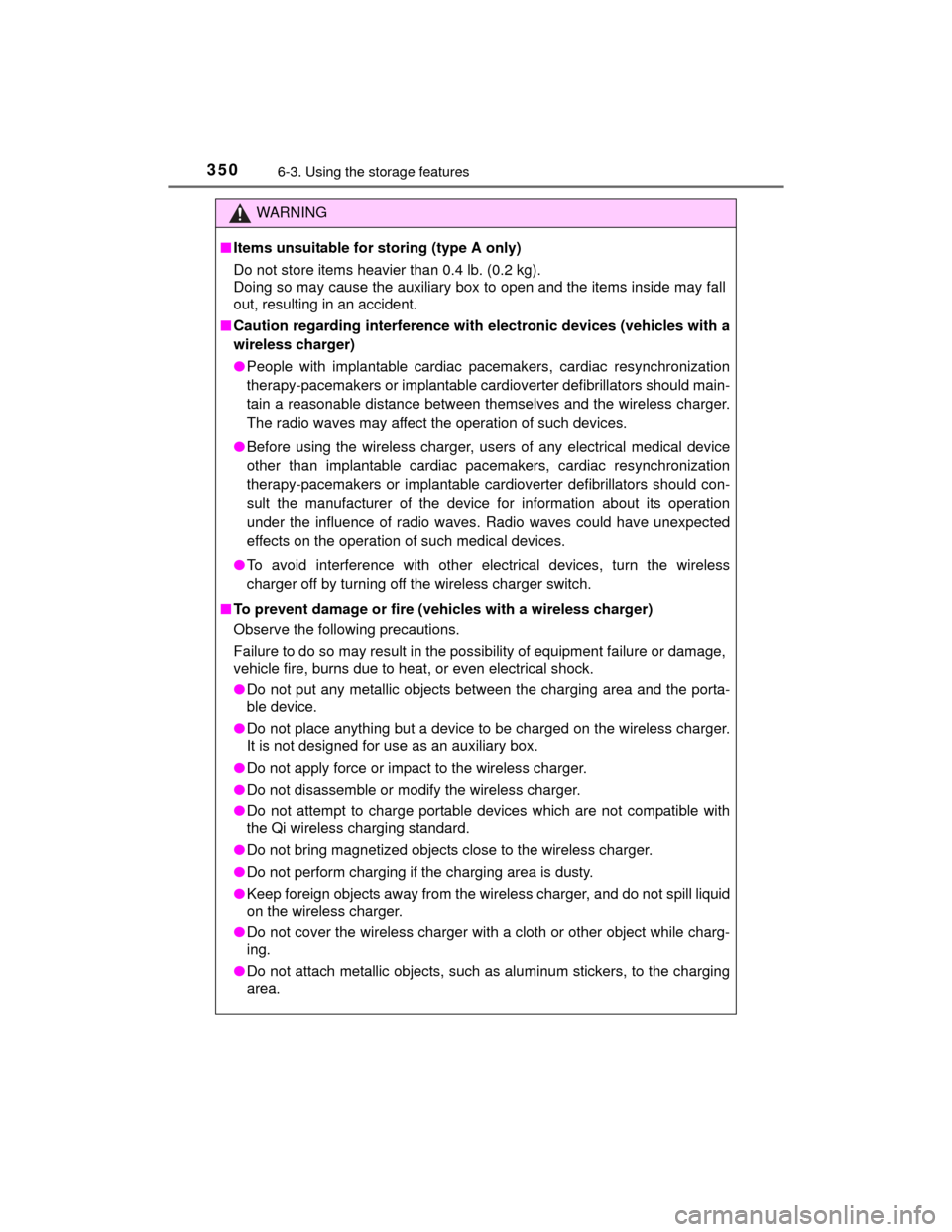
3506-3. Using the storage features
CAMRY_HV_U (OM33A87U)
WARNING
■Items unsuitable for storing (type A only)
Do not store items heavier than 0.4 lb. (0.2 kg).
Doing so may cause the auxiliary box to open and the items inside may fall
out, resulting in an accident.
■ Caution regarding interference with electronic devices (vehicles with a
wireless charger)
●People with implantable cardiac pacemakers, cardiac resynchronization
therapy-pacemakers or implantable card ioverter defibrillators should main-
tain a reasonable distance between themselves and the wireless charger.
The radio waves may affect the operation of such devices.
● Before using the wireless charger, users of any electrical medical device
other than implantable cardiac pacemakers, cardiac resynchronization
therapy-pacemakers or implantable cardioverter defibrillators should con-
sult the manufacturer of the device for information about its operation
under the influence of radio waves. Radio waves could have unexpected
effects on the operation of such medical devices.
● To avoid interference with other electrical devices, turn the wireless
charger off by turning off the wireless charger switch.
■ To prevent damage or fire (vehicles with a wireless charger)
Observe the following precautions.
Failure to do so may result in the possibility of equipment failure or damage,
vehicle fire, burns due to heat, or even electrical shock.
●Do not put any metallic objects between the charging area and the porta-
ble device.
● Do not place anything but a device to be charged on the wireless charger.
It is not designed for use as an auxiliary box.
● Do not apply force or impact to the wireless charger.
● Do not disassemble or modify the wireless charger.
● Do not attempt to charge portable devices which are not compatible with
the Qi wireless charging standard.
● Do not bring magnetized objects close to the wireless charger.
● Do not perform charging if the charging area is dusty.
● Keep foreign objects away from the wireless charger, and do not spill liquid
on the wireless charger.
● Do not cover the wireless charger with a cloth or other object while charg-
ing.
● Do not attach metallic objects, such as aluminum stickers, to the charging
area.
Page 351 of 564
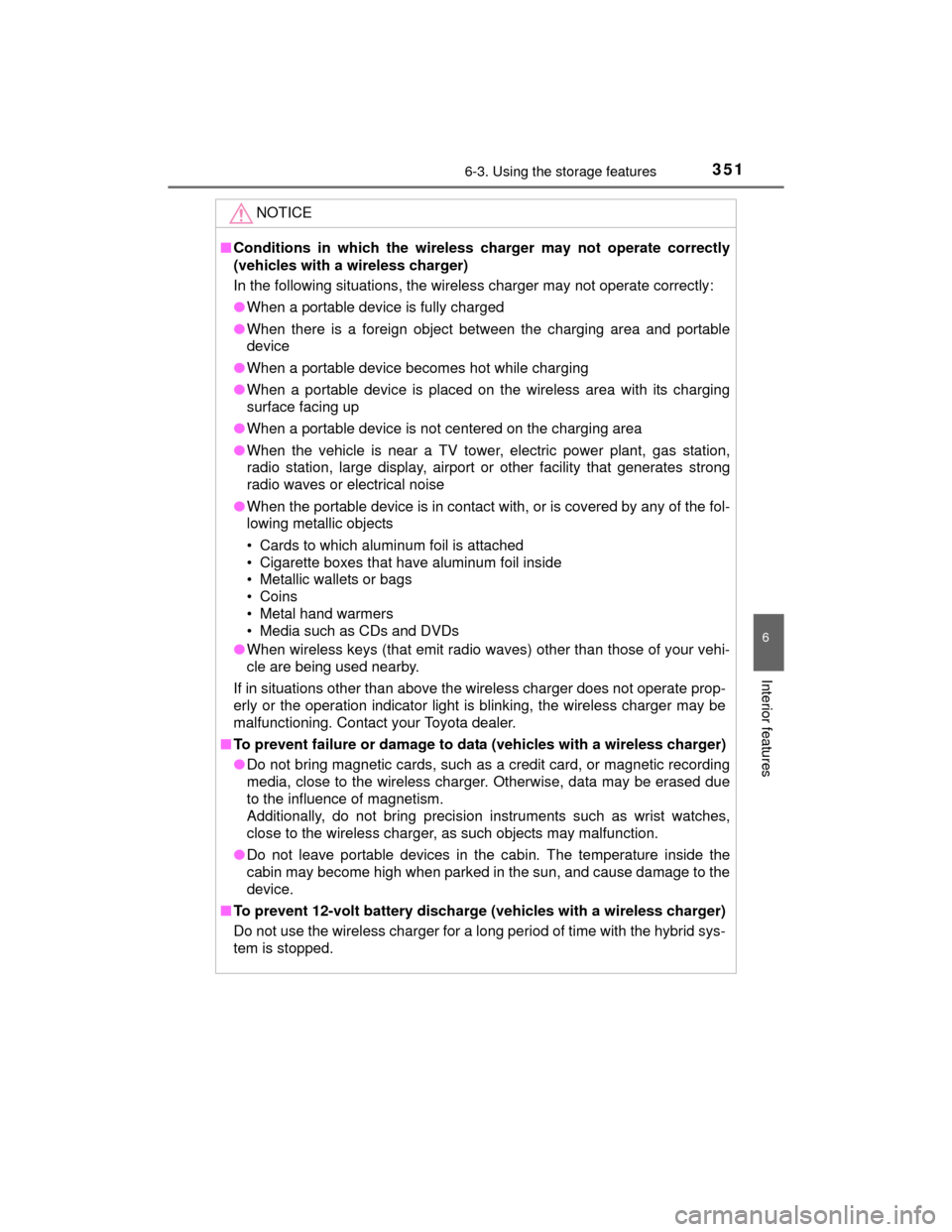
3516-3. Using the storage features
6
Interior features
CAMRY_HV_U (OM33A87U)
NOTICE
■Conditions in which the wireless charger may not operate correctly
(vehicles with a wireless charger)
In the following situations, the wireless charger may not operate correctly:
●When a portable device is fully charged
● When there is a foreign object between the charging area and portable
device
● When a portable device becomes hot while charging
● When a portable device is placed on the wireless area with its charging
surface facing up
● When a portable device is not centered on the charging area
● When the vehicle is near a TV tower, electric power plant, gas station,
radio station, large display, airport or other faci lity that generates strong
radio waves or electrical noise
● When the portable device is in contact with, or is covered by any of the fol-
lowing metallic objects
• Cards to which aluminum foil is attached
• Cigarette boxes that have aluminum foil inside
• Metallic wallets or bags
• Coins
• Metal hand warmers
• Media such as CDs and DVDs
● When wireless keys (that emit radio waves) other than those of your vehi-
cle are being used nearby.
If in situations other than above the wireless charger does not operate prop-
erly or the operation indicator light is blinking, the wireless charger may be
malfunctioning. Contact your Toyota dealer.
■ To prevent failure or damage to data (vehicles with a wireless charger)
●Do not bring magnetic cards, such as a credit card, or magnetic recording
media, close to the wireless charger. Otherwise, data may be erased due
to the influence of magnetism.
Additionally, do not bring precision instruments such as wrist watches,
close to the wireless charger, as such objects may malfunction.
● Do not leave portable devices in the cabin. The temperature inside the
cabin may become high when parked in the sun, and cause damage to the
device.
■ To prevent 12-volt battery discharge (vehicles with a wireless charger)
Do not use the wireless charger for a long period of time with the hybrid sys-
tem is stopped.
Page 369 of 564

3696-4. Other interior features
6
Interior features
CAMRY_HV_U (OM33A87U)
Important! Read this information before using Safety Connect.
■Exposure to radio frequency signals
The Safety Connect system installed in your vehicle is a low-power
radio transmitter and receiver. It receives and also sends out radio
frequency (RF) signals.
In August 1996, the Federal Communications Commission (FCC)
adopted RF exposure guidelines with safety levels for mobile wire-
less phones. Those guidelines are consistent with the safety stan-
dards previously set by the following U.S. and international
standards bodies.
●ANSI (American National Standards Institute) C95.1 [1992]
● NCRP (National Council on Radiation Protection and Measure-
ment) Report 86 [1986]
● ICNIRP (International Commission on Non-Ionizing Radiation
Protection) [1996]
Those standards were based on comprehensive and periodic eval-
uations of the relevant scientific literature. Over 120 scientists, engi-
neers, and physicians from universities, and government health
agencies and industries reviewed the available body of research to
develop the ANSI Standard (C95.1).
The design of Safety Connect complies with the FCC guidelines in
addition to those standards.
■ Certification for Safety Connect
FCC ID: O6Y-CDMRF101
FCC ID: XOECDMRF101B
FCC ID: N7NGTM2
NOTE:
This device complies with Part 15 of the FCC Rules. Operation is subject to
the following two conditions: (1) This device may not cause harmful interfer-
ence, and (2) this device must accept any interference received, including
interference that may cause undesired operation.
FCC WARNING:
Changes or modifications not expressly approved by the party responsible for
compliance could void the user's authority to operate the equipment.
Safety information for Safety Connect
Page 411 of 564

4117-3. Do-it-yourself maintenance
7
Maintenance and care
CAMRY_HV_U (OM33A87U)■
Situations in which the tire pressure warning system may not oper-
ate properly (vehicles with a tire pressure warning system)
●In the following cases, the tire pressure warning system may not operate
properly.
• If non-genuine Toyota wheels are used.
• A tire has been replaced with a tire that is not an OE (Original Equip-
ment) tire.
• A tire has been replaced with a tire that is not of the specified size.
• Tire chains etc. are equipped.
• If a window tint that affects the radio wave signals is installed.
• If there is a lot of snow or ice on the vehicle, particularly around the wheels or wheel housings.
• If the tire inflation pressure is extremely higher than the specified level.
• If tires not equipped with tire pressure warning valves and transmit-
ters are used.
• If the ID code on the tire pressure warning valves and transmitters is not registered in the tire pressure warning computer.
●Performance may be affected in the following situations.
• Near a TV tower, electric power plant, gas station, radio station, large
display, airport or other facility that generates strong radio waves or
electrical noise
• When carrying a portable radio, cellular phone, cordless phone or other wireless communication device
If tire position information is not correctly displayed due to the radio
wave conditions, the display may be corrected by driving and changing
the radio wave conditions.
●When the vehicle is parked, the time taken for the warning to start or go
off could be extended.
●When tire inflation pressure declines rapidly for example when a tire has
burst, the warning may not function.
Page 460 of 564
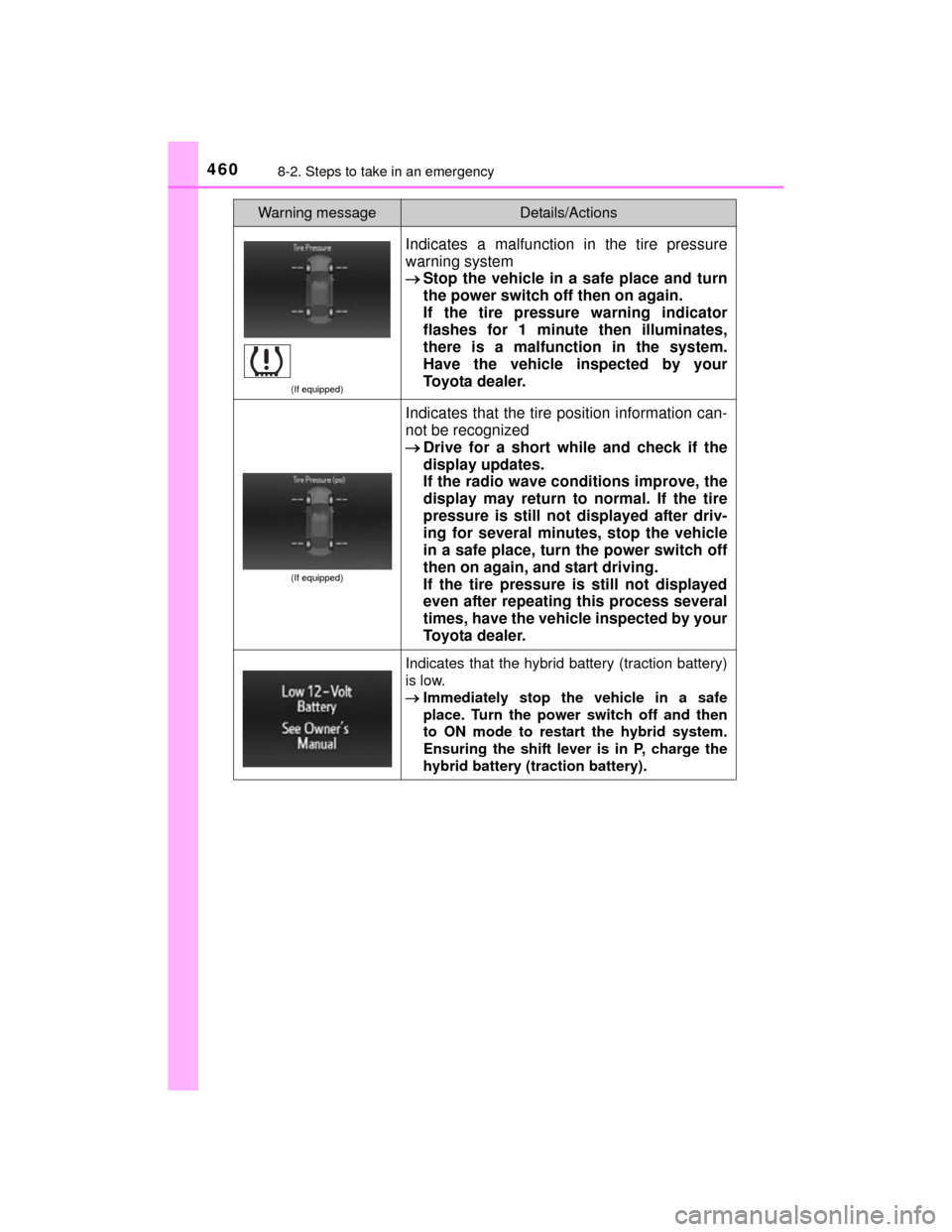
4608-2. Steps to take in an emergency
CAMRY_HV_U (OM33A87U)
(If equipped)
Indicates a malfunction in the tire pressure
warning system
Stop the vehicle in a safe place and turn
the power switch off then on again.
If the tire pressure warning indicator
flashes for 1 minute then illuminates,
there is a malfunction in the system.
Have the vehicle inspected by your
Toyota dealer.
(If equipped)
Indicates that the tire position information can-
not be recognized
Drive for a short while and check if the
display updates.
If the radio wave conditions improve, the
display may return to normal. If the tire
pressure is still not displayed after driv-
ing for several minutes, stop the vehicle
in a safe place, turn the power switch off
then on again, and start driving.
If the tire pressure is still not displayed
even after repeating this process several
times, have the vehicle inspected by your
Toyota dealer.
Indicates that the hybrid battery (traction battery)
is low.
Immediately stop the vehicle in a safe
place. Turn the power switch off and then
to ON mode to restart the hybrid system.
Ensuring the shift lever is in P, charge the
hybrid battery (traction battery).
Warning messageDetails/Actions
Page 517 of 564
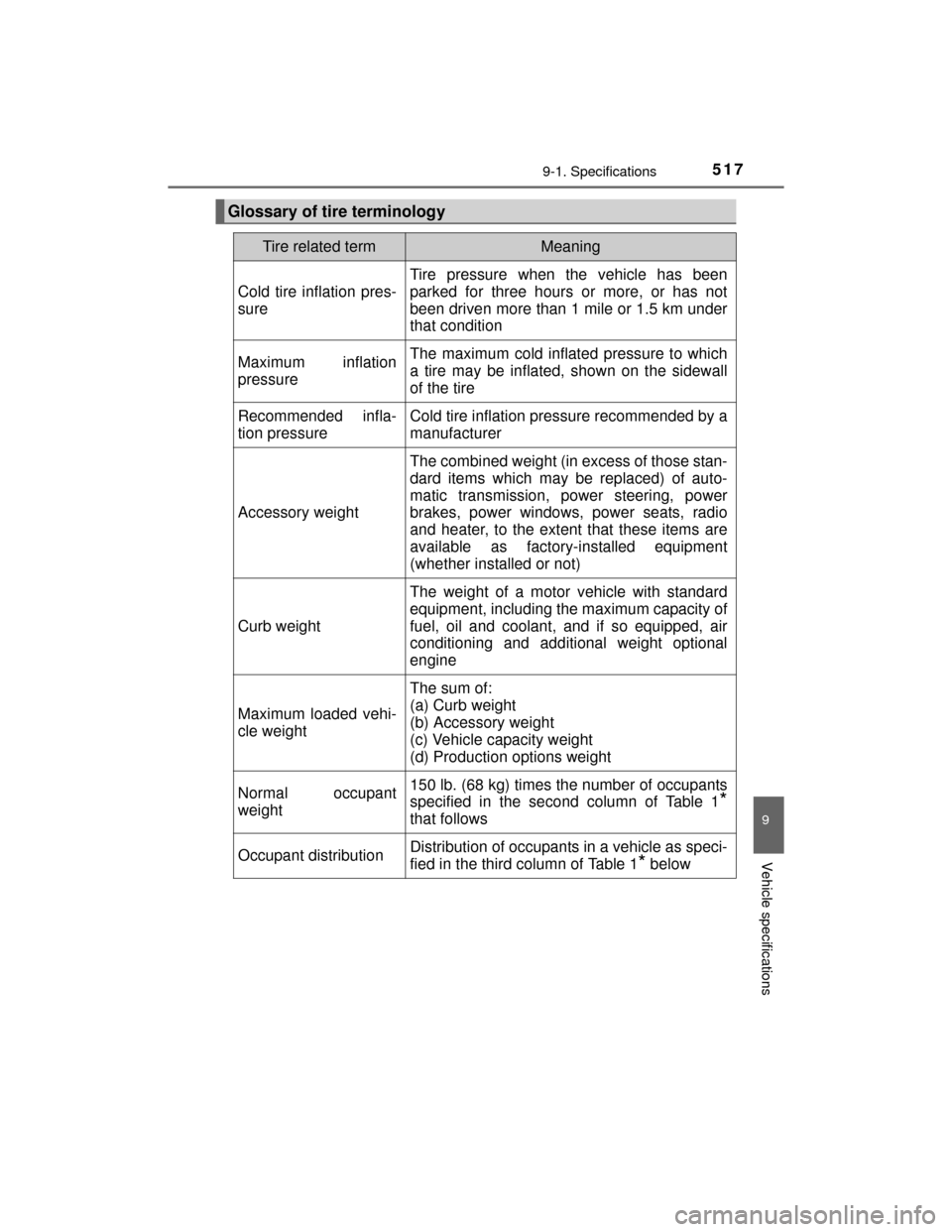
5179-1. Specifications
9
Vehicle specifications
CAMRY_HV_U (OM33A87U)
Glossary of tire terminology
Tire related termMeaning
Cold tire inflation pres-
sure
Tire pressure when the vehicle has been
parked for three hours or more, or has not
been driven more than 1 mile or 1.5 km under
that condition
Maximum inflation
pressureThe maximum cold inflated pressure to which
a tire may be inflated, shown on the sidewall
of the tire
Recommended infla-
tion pressureCold tire inflation pressure recommended by a
manufacturer
Accessory weight
The combined weight (in excess of those stan-
dard items which may be replaced) of auto-
matic transmission, power steering, power
brakes, power windows, power seats, radio
and heater, to the extent that these items are
available as factory-installed equipment
(whether installed or not)
Curb weight
The weight of a motor vehicle with standard
equipment, including the maximum capacity of
fuel, oil and coolant, and if so equipped, air
conditioning and additional weight optional
engine
Maximum loaded vehi-
cle weight
The sum of:
(a) Curb weight
(b) Accessory weight
(c) Vehicle capacity weight
(d) Production options weight
Normal occupant
weight150 lb. (68 kg) times the number of occupants
specified in the second column of Table 1
*
that follows
Occupant distributionDistribution of occupants in a vehicle as speci-
fied in the third column of Table 1
* below
Page 545 of 564
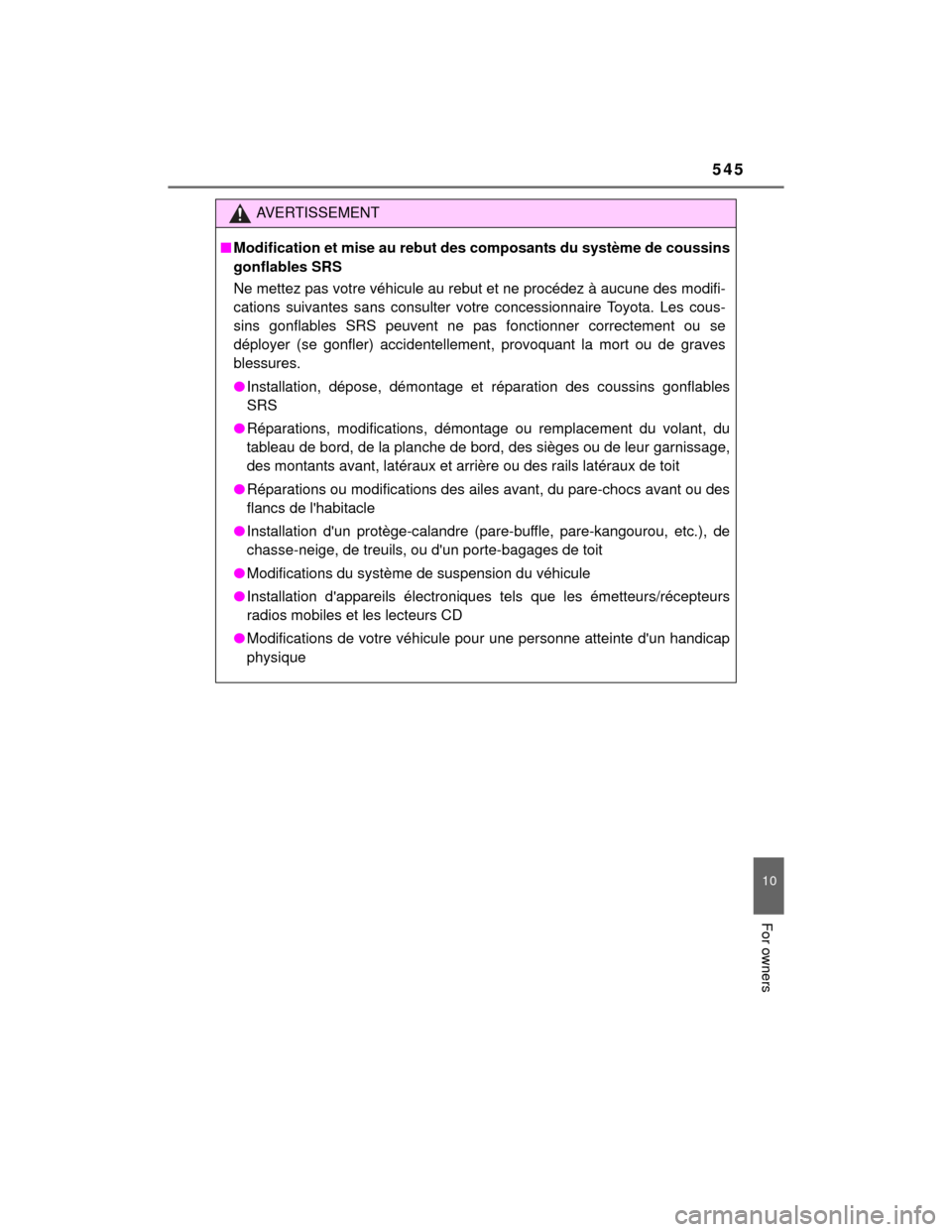
545
10
For owners
CAMRY_HV_U (OM33A87U)
AVERTISSEMENT
■Modification et mise au rebut des composants du système de coussins
gonflables SRS
Ne mettez pas votre véhicule au rebut et ne procédez à aucune des modifi-
cations suivantes sans consulter votre concessionnaire Toyota. Les cous-
sins gonflables SRS peuvent ne pas fonctionner correctement ou se
déployer (se gonfler) accidentellement, provoquant la mort ou de graves
blessures.
● Installation, dépose, démontage et ré paration des coussins gonflables
SRS
● Réparations, modifications, démontage ou remplacement du volant, du
tableau de bord, de la planche de bord, des sièges ou de leur garnissage,
des montants avant, latéraux et arrière ou des rails latéraux de toit
● Réparations ou modifications des ailes avant, du pare-chocs avant ou des
flancs de l'habitacle
● Installation d'un protège-calandre (pare-buffle, pare-kangourou, etc.), de
chasse-neige, de treuils, ou d'un porte-bagages de toit
● Modifications du système de suspension du véhicule
● Installation d'appareils électroniques tels que les émetteurs/récepteurs
radios mobiles et les lecteurs CD
● Modifications de votre véhicule pour une personne atteinte d'un handicap
physique